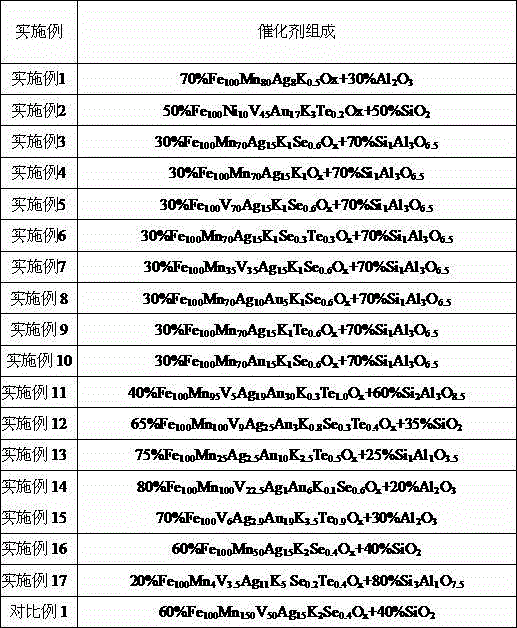Catalyst for producing low-carbon olefin as well as preparation method and using method of catalyst
A low-carbon olefin and catalyst technology, which is applied in the field of production of low-carbon olefin catalysts, can solve the problems of low activity and selectivity at low temperatures, achieve high activity and low-carbon olefin selectivity, promote dispersion, and promote the effect of reduction
- Summary
- Abstract
- Description
- Claims
- Application Information
AI Technical Summary
Problems solved by technology
Method used
Image
Examples
Embodiment 1
[0033] Take 160.7 grams of ferric nitrate, 0.23 grams of potassium nitrate and 6.24 grams of silver nitrate and dissolve them in 100 milliliters of water to form solution I with a certain concentration, and dissolve 131.5 grams of manganese nitrate solution with a concentration of 50% by mass in 100 milliliters of water to obtain solution II Add solution II to solution I to obtain mixture I, add 120 grams of aluminum sol with a mass content of 25% alumina to mixture I and adjust the pH value to 8 with ammonia water to obtain mixture II, heat and concentrate mixture II in a boiling water bath to The solid content is 55% by weight to obtain a slurry, and the slurry is dried at 80° C. with hot air with a relative humidity of 90% for 12 hours to obtain a catalyst precursor, and the catalyst precursor is roasted at 750° C. for 3 hours to obtain a catalyst, which consists of: 70% Fe 100 mn 80 Ag 8 K 0.5 Ox+30%Al 2 o 3 . The catalyst is pulverized and screened with 20-40 mesh p...
Embodiment 2
[0036] Take 106.2 grams of ferric nitrate, 21.2 grams of chloroauric acid solution, 8.82 grams of nickel nitrate and 0.92 grams of potassium nitrate and dissolve them in 100 milliliters of water to form a solution of a certain concentration. Dissolve 15.97 grams of ammonium metavanadate and 0.14 grams of ammonium tellurate in In 100 milliliters of water, solution II was obtained, solution II was added to solution I to obtain mixture I, 125 grams of silica sol with a silicon oxide mass content of 40% was added to mixture I and the pH value was adjusted to 8 with ammonia water to obtain mixture II, and mixture II was placed in Heat and concentrate in a boiling water bath to a solid content of 55% by weight to obtain a slurry, dry the slurry at 90°C with hot air with a relative humidity of 90% for 5 hours to obtain a catalyst precursor, and roast the catalyst precursor at 650°C for 5 hours to obtain Catalyst, its composition is: 50% Fe 100 Ni 10 V 45 Au 17 K 3 Te 0.2 Ox+50%S...
Embodiment 3
[0039] Get 68.35 grams of ferric nitrate, 0.2 grams of potassium nitrate and 4.98 grams of silver nitrate dissolved in 100 milliliters of water to make a certain concentration of solution I, 0.21 grams of ammonium selenate and 48.9 grams of manganese nitrate solution with a concentration of 50% by mass are dissolved in In 100 milliliters of water, solution II was obtained, and solution II was added to solution I to obtain mixture I, and 49.3 grams of silica sol with a mass content of silicon oxide of 40% and 201.1 grams of aluminum sol with a mass content of alumina of 25% were added to mixture I and adjusted with ammonia water When the pH value reaches 10, the mixture II is obtained, and the mixture II is heated and concentrated in a boiling water bath to a solid content of 55% by weight to obtain a slurry, and the slurry is dried at 80°C with hot air with a relative humidity of 90% for 24 hours to obtain a catalyst precursor , the catalyst precursor was calcined at 750°C for ...
PUM
 Login to View More
Login to View More Abstract
Description
Claims
Application Information
 Login to View More
Login to View More - R&D
- Intellectual Property
- Life Sciences
- Materials
- Tech Scout
- Unparalleled Data Quality
- Higher Quality Content
- 60% Fewer Hallucinations
Browse by: Latest US Patents, China's latest patents, Technical Efficacy Thesaurus, Application Domain, Technology Topic, Popular Technical Reports.
© 2025 PatSnap. All rights reserved.Legal|Privacy policy|Modern Slavery Act Transparency Statement|Sitemap|About US| Contact US: help@patsnap.com

